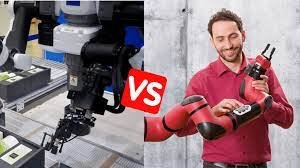
Introduction
Collaborative robots, also known as cobots have completely altered the landscape of industrial automation for the years to come. They foster a new era of human-machine collaboration as they are engineered to work seamlessly alongside human operators. Cobots provide efficiency, increased flexibility, and adaptability in manufacturing processes. It has become increasingly evident that these collaborative robots, provide easy solutions to many challenges with a unique set of attributes. Moreover, cobots have improved safety protocols and enhanced versatility making them way more efficient than conventional industrial robots. These collaborative robots pave the way for more seamless integration of automation in diverse industries.
Safety
Cobots are equipped with safety sensors and technology that can sense the surrounding environment and the presence of human operators in real-time to avoid collisions and injuries. This enables them to work in close proximity to human operators without compromising their safety, hence, preventing collisions and minimizing the risk of injuries. These safety measures are one of the features that sets collaborative robots apart from traditional industrial robots. Cobots facilitate a collaborative and adaptable workspace where humans and machines can easily work together without any constraints. This opens up many new opportunities for dynamic task sharing between robots and humans. Enhancing productivity and enabling fluid interactions between workers and machines, cobots ultimately contribute to a safer and more efficient manufacturing environment.
In contrast, traditional industrial robots usually need to operate within a fixed work area and protect personnel through safety fences or light curtains. This limits the overall flexibility and efficiency of manufacturing processes, thus, lacking the ability to adapt to changing conditions in their environment.
Flexibility
Cobots usually have flexible movement capabilities and are easily reconfigurable, allowing them to quickly adapt to different tasks and work environments. They are designed to have versatile movement capabilities which allows them to easily navigate through dynamic environments and complete a wide range of tasks. Furthermore, they also have user-friendly interfaces and programming systems that enable non-experts to quickly reprogram them for different applications. This empowers operators to make easy adjustments to the robot’s workflow without the need for specialized programming skills.
Meanwhile, traditional industrial robots often require complex programming and setup to adapt to new tasks and workflows. All in all, the combination of flexible movement capabilities and easy reconfigurability positions makes cobots agile in providing adaptable solutions in comparison to traditional industrial robots.
Intuitiveness
Cobots usually support intuitive human-computer interaction methods, such as touch screens, gesture recognition, and voice control, making interaction with the robot simpler and more natural. This distinctive advantage sets them apart from traditional industrial counterparts as they put special emphasis on intuitive human-computer interaction (HCI) methods. This intuitive interaction facilitates natural engagement between human operators and the robot, providing access to automation and thus reducing the barriers associated with complex programming.
In contrast, traditional industrial robots usually require specialized programming and control technology and place higher demands on operators. Industrial robots involve complex code development and precise calibration tasks which are performed by highly skilled technicians and engineers. This limits the accessibility of these robots to only highly trained professionals. The integration of intuitive human-computer interaction methods in cobots streamlines the programming and contributes to a more user-friendly and better accessible automation environment.
Cooperation
Cobots are designed to work with humans and can operate in the same workspace as human operators. This is a distinct characteristic that allows them to collaborate seamlessly with human operators within the same workspace. They can sense and understand human intentions and adjust their behavior accordingly, enabling more efficient collaborative work. This way, a workplace is created where the strengths of both humans and machines can be harnessed for optimal efficiency. Furthermore, advanced sensor technologies enable
Traditional industrial robots typically work independently with less interaction with human operators. They are confined to fixed work areas and enclosed spaces which are separated from humans by the use of safety barriers. They cannot adapt to the presence or actions of nearby humans therefore; they typically operate independently. The design strategies of cobots emphasize collaboration that enables them to work in perfect harmony with humans in shared workspaces.
Scope of application
Cobots have advantages in a wider range of applications, including flexible manufacturing, service industries, and assisted healthcare. Their versatility across this wide spectrum of applications sets them apart from traditional industrial robots. Their ability to be easily reprogrammed and reconfigured makes them well-suited for various industries as they can easily adjust to different manufacturing requirements.
Whereas traditional industrial robots are mainly used for repetitive and high-precision manufacturing tasks. These robots struggle to adapt to the diverse and ever-evolving demands of industries beyond manufacturing.
Deployment costs
Cobots generally have low deployment costs because they can integrate with existing work environments and equipment and do not require expensive safety measures such as safety fencing. This makes them easily accessible to a broader range of industries and applications. Their integration capabilities eliminate the need for extensive modifications which reduces deployment time and costs. Their advanced safety sensors and collision detection technology allows them to work alongside human workers without the need for physical barriers.
In comparison, the deployment cost of traditional industrial robots is usually higher and requires special work area division and safety facilities. They require protective measures, and substantial reprogramming and can only be operated by highly trained engineers.
Conclusion
All in all, collaborative robots (cobots) are transformative in industrial automation and offer a variety of distinct advantages over traditional industrial robots. The flexibility, safety features and human-computer interaction methods provided by cobots address critical challenges that are faced by manufacturers in this day and age. They enhance workplace safety and create a collaborative environment where humans and machines can complete tasks efficiently. Moreover, they reduce downtime and increase the overall efficiency. These collaborative robots encourage a more natural and collaborative relationship between humans and robots.
